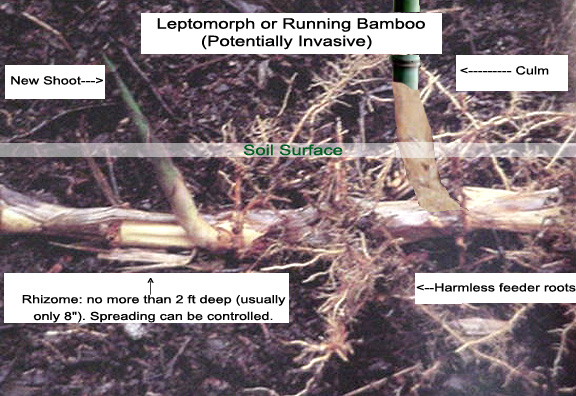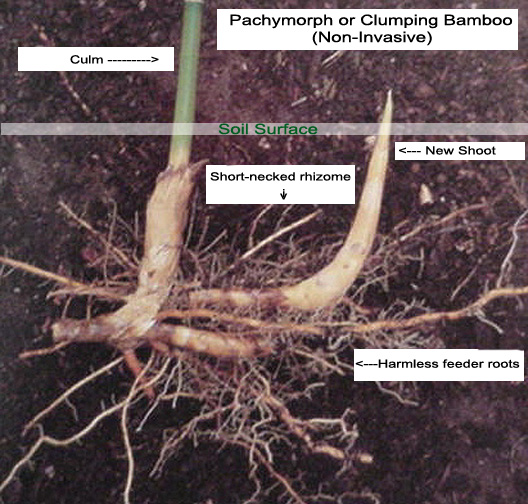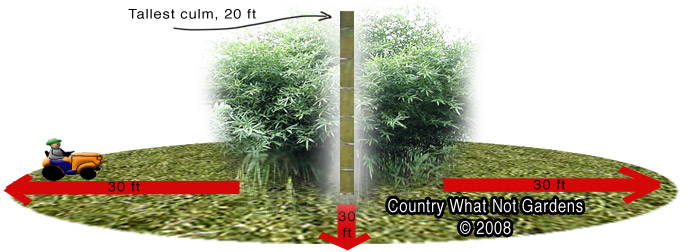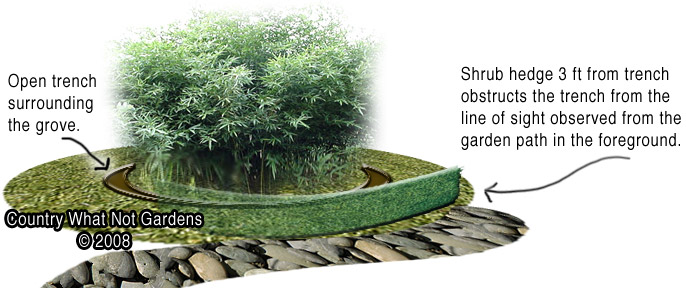| |
|
|
|
|
 |
|
Like us and follow us on Facebook for availability updates and tips on bamboo growing and management.
|
|
|
| |
|
|
|
|
The below information may seem like a lot to take in, but we welcome you to contact us if you have any questions.
Planting dates -
For smaller plants we recommend that mid-September be the latest date for zone 5. Planting for zone 6 can stretch into October.
The reason for these deadlines is that smaller root balls sizes 1 through 5 gallons can sometimes be heaved out of the ground by the freezing and thawing if the roots don't have time to grow into the surrounding soil before winter arrives.
This is of less concern with larger root balls of sizes 10 gallons, 14 gallons, and up.
Which bamboo to plant -
All bamboo is not created equally. There are about 2,000. Only a fraction of these are hardy to zone 5, but they range from small to tall, from green to variegated, sun loving to requiring shade. These cold hardy species span many genera, but all have the distinct bamboo family resemblance.
The facts reguarding invasive or non-invasive is more than either running or clumping.
To fully understand spreading rates of any given species the main question to ask, is not only if it's running (leptomorph) or clumping (pachymorph), but also is it diffuse or caespitose and how fast does it spread in your climate. Usually even the worse runners in warm climates grown in perfect soil will not invade at any such rate in USDA zone 5. This is especially true if it's grown in heavier soils such as clay.
 
So what exactly are diffuse and caespitose?
Diffuse can be defined as a root system that grows quickly and has a great distance between culms.
Caespitose describes a root system that has very closely spaced culms and grow so slow that yearly increase in some cases is barely noticed.
The examples below are listed in order from most to least invasive.
Running / Diffuse
Running / Caespitose
Clumping / Diffuse (No diffuse clumpers are hardy to zone 5, most are tropical or subtropical species.)
Clumping / Caespitose
Ground temperature also plays an important role in at what rate a bamboo spreads. Here in northern Indiana the ground does not become warm enough for the root systems to advance until near the end of summer. By that time they soon cool down again. This leaves a time window of just a couple weeks in which it can claim new ground. This can be good or bad depending on what you're growing. If you're growing a diffuse runner you can be thankful for such a growth situation. However, if you prefer clumpers (especially those which are caespitose) you will barely be able to see any yearly increase in clump size for many years, decades, or even for as long as the plant lives.
Cold Hardy Bamboo Growing Information
Bamboo is the mostly evergreen grass that "thinks" it's a tree and is deservingly so becoming more popular. More people are finding that it's not an invasive monster in the north. It simply requires a little care and some thought about the best place to plant it, as with any other plant.
Bamboo's bad reputation has mostly come from people planting the wrong species in the wrong location. Seriously, would you plant a large shade tree such as a sugar maple which can reach a height of about 80 ft. in your small 10'X15' town dwelling back yard? Likewise you would not plant a bamboo that can reach a great spread there either.
No matter what you plant, it's important to plant according to your space. There are plenty of small bamboo. Types of bamboo hardy to our zone 5 area can range in height from just 1 foot to over 20 feet.
The smaller bamboo types that grow under 2' in height, especially species in the genera Sasa and Pleioblastus, are grown more as ornamental grasses. Even though they are evergreen in warmer zones, the old growth is typically mowed down before the beginning of the shooting season in early spring.
One species, Sasa veitchii, is customarily mowed to the ground each year in Japan before new growth begins, no matter if it needs it or not. In our experience Sasa veitchii isn't quite cold hardy to USDA zone 5, but we do have its very similar cousin, Sasa hayatea. Such small bamboo typically top kill during the winter in zone 5 anyway and are mowed off before new shoots appear for aesthetic reasons.
A mid-sized bamboo that can also be grown as an ornamental grass in zone 5 is Pseudosasa japonica and its subspecies 'Tsutsumiana'. During the growing season its larger leaves provide a wonderful tropical look to the garden.
Our 12 year old plant of P. japonica was started from a 1 gallon plant and the loose clump has yet to reach 3' in diameter. It's classified as a runner, but it's a remarkably slow one. It top kills during the winter in zone 5, which serves to curb the growth of this already more subdued grower. It re-shoots well and can be maintained with a once a year mowing in the early spring to remove the old growth before new growth begins.
Our Hibanobambusa has followed the same pattern as our Pseudosasa. Hibanobambusa can also be grown as a beautiful and striking mid-sized ornamental grass in USDA zone 5.
Small bamboo aside, the larger and more cold hardy species such as Phyllostachys bissetii and Phyllostachys nuda typically don't top kill during the winter in zone 5 once they're thoroughly established. Though leaf burn can be common, complete top kill of established groves mostly happens only during severe winters.
If you're planning to make a large area to fill with a larger bamboo then by all means go for it. This area, once the large bamboo is established, can be under planted to form a high-branched stand, forest, or dry shade garden. In general, bamboo grows thick enough to choke out any weeds and an area designed to be under planted may need to be thinned a little; and perennials will need supplemental watering until established.
Containment of Running Bamboo -
"Running" is a variable term. Rates at which running bamboo spreads varies upon the species.
A large sun loving bamboo can be controlled in the following ways:
Natural barriers are the best. A sun loving bamboo will not venture far into the shade of a forest, and no bamboo will cross standing water.
• Mowing Method
A 30 ft expanse of lawn surrounding the area you devote to the running bamboo that can be mowed in the spring will control it.
Bamboo can only send rhizomes out from the edge of the grove as far the distance of the height of the tallest culm in the grove. So if a grove's tallest culm is 20 ft in height, it will not be able to cross an expanse of lawn 30 ft from all sides of the grove.
It will send up new shoots within that 30 ft zone, but keeping these new shoots mowed off each spring will prevent the rhizomes from producing culms and leaves by which to gather energy from the sun to grow any further.
The total area represented in the below illustration is a piece of ground 80 ft in diameter; 30 ft on all sides of a 20 ft diameter grove.

•Trenching Method
Another way to contain a running bamboo is the trenching method. An open trench 12" to 18" wide and deep surrounding the grove on all sides will provide an open view to any rhizomes that attempt to spread beyond the area allowed for the grove. This open trench will be more easily maintained in a clay based soil than in a looser soil such as loam.
Rhizomes only spread once a year during the late summer to early autumn. During a period of a few weeks each year the rhizome will grow from the planting bed into this trench where they can be cut back with pruning shears.
We have successfully contained a small grove of Phyllostachys bissetii to a 6 ft x 8 ft area for 10 years using this method.
If the open trench would pose any aesthetic problems it can be hidden from sight by planting a shrub hedge between it and the garden path.

It should be noted that while the mowing and trenching methods of containment work well for nearly all larger running bamboo species, neither of those methods will work for the small species within the genus Pleioblastus. Rhizomes of those species will simply grow down the sides of a trench instead growing straight out of them as would those of larger species. The reason that the mowing method will not work is due to their ability to form leaves on culm shorter than the mowing height.
Pleioblastus species should either be grown as container plants or planted in very large areas where they can form a mass planting of ground cover.
There are also thick plastic barriers, for putting in the ground, on the market. We do not carry those, but can help you find them.
Clumping bamboo is completely non-invasive. Species within the Fargesia genus only reach a spread of about 12 ft. during it's entire life of 60-100 years. This slow growth lends these species well to small gardens where a larger area of bamboo is not desired. However, any Fargesia species requires shade year round. There is no clumping species hardy this far north, zone 5, that can take sun. The sun loving bamboo hardy here will all run slowly to rapidly.
Siting -
There is a cold hardy bamboo for nearly any situation, sun or shade, grove use, shrub form, or ground cover. They exist in color patterns varying from dark to light green, even with variegation on the culms and/or leaves. The culms can be for instance green with yellow stripes or vise-versa.
Siting the bamboo is very important. If you live in colder regions such as zones 5-6 it would be best to site the grove in an area where it will not be exposed to winter winds. While cold temperatures are not much of a problem for cold hardy species, wind is. Winter wind will quickly desiccate the leaves and culms.
If this happens, new shoots will emerge from the ground in the spring, but the grove will remain stunted never reach its maximum height if this top-killing happens on a yearly basis.
Here in northern Indiana the worse winter winds comes from the west. So planting bamboo on the east side of a windbreak will prevent wind damage.
Soil -
Bamboo requires well drained soil. It's drought tolerant once it's well established, but it should be kept evenly moist and not soggy while it's establishing.
Planting the bamboo rootball on top of a 6" deep layer of composted manure and backfilling the hole around the rootball with a mix of 1/3 composted manure, 1/3 good top soil, and 1/3 compost or peat moss will get the plant off to a good start.
Mulch can be applied on top of the planting area to help the soil retain moisture and to help protect the roots from cold for the first couple of winters.
Fertilizing -
Bamboo will grow okay without fertilizer, but being that it is a heavy feeder it will grow much better if fed properly. First year plantings should only be fertilized with well composted manure as not to burn the new plant. Starting the second year and every year thereafter it should be fertilized three times a year. For good growth you can follow this fertilizing schedule every year after the first year.
Spring ( late Feb.- early March ) high nitrogen, 42-0-0: cover the ground with 3"-4" of composted manure and scatter one cupped hand full of urea per 3 square ft. of manure.
Summer ( mid June ) balanced fertilizer: 20-20-20
Fall ( mid September) low nitrogen: 5-10-10, or similar.
Grove Maintenance -
Third or fourth year and every year there after:
In northern climates it takes a little maintenance to make the larger bamboo species look like a nice grove. For the biggest culms, in mid summer after the new shoots have reached full size, remove 1/3 of the smallest and weakest culms. These small ones are usually in the shaded interior of the grove. There they receive no sun light to contribute any energy to the grove. The grove is spending energy to feed these small culms and not getting anything back in return. This culling should not take place until the third or fourth year because doing it before this can weaken the plant or kill it.
For smaller species such as members of the Pleioblastus genus, mowing to a couple inches in height once every few years will rejuvenate the miniature grove even if it doesn't top kill during winter.
Choosing bamboo based on your USDA growing zone -
Knowing your growing zone and minimum winter temperature will help you in selecting a bamboo for your region and purpose.
If you live in zone 5 and experience a minimum winter temperature of -20ºF you have a couple options.
You can grow smaller bamboo that are only cold hardy to around 0ºF to -10ºF. They will top kill like ornamental grasses and regrow in the spring. The roots are more cold hardy than the aerial portions and will survive to produce fresh growth in the spring.
The other option is choosing a larger bamboo that is cold hardy to -20ºF. It will grow into a taller, more stately grove and, once it's a well established grove, it will only top kill during severe winters; though winter leaf burn may be more common.
Use your zip code to find your USDA growing zone below.
Average Annual Extreme Minimum Temperature 1976 - 2005
|
| ºF |
Zone
|
ºC |
|
ºF |
Zone
|
ºC |
|
ºF |
Zone
|
ºC |
|
ºF |
Zone
|
ºC |
| |
|
|
|
|
|
|
|
|
|
|
|
|
|
|
-60
to
-55 |
1a |
-51.1
to
-48.3 |
|
-25
to
-20 |
4b |
-31.7
to
-28.9 |
|
10
to
15 |
8a |
-12.2
to
-9.4 |
|
45
to
50 |
11b |
7.2
to
10 |
| |
|
|
|
|
|
|
|
|
|
|
|
|
|
|
-55
to
-50 |
1b |
-48.3
to
-45.6 |
|
-20
to
-15 |
5a |
-28.9
to
-26.1 |
|
15
to
20 |
8b |
-9.4
to
-6.7 |
|
50
to
55 |
12a |
10
to
12.8 |
| |
|
|
|
|
|
|
|
|
|
|
|
|
|
|
-50
to
-45 |
2a |
-45.6
to
-42.8 |
|
-15
to
-10 |
5b |
-26.1
to
-23.3 |
|
20
to
25 |
9a |
-6.7
to
-3.9 |
|
55
to
60 |
12b |
12.8
to
15.6 |
| |
|
|
|
|
|
|
|
|
|
|
|
|
|
|
-45
to
-40 |
2b |
-42.8
to
-40 |
|
-10
to
-5 |
6a |
-23.3
to
-20.6 |
|
25
to
30 |
9b |
-3.9
to
-1.1 |
|
60
to
65 |
13a |
15.6
to
18.3 |
| |
|
|
|
|
|
|
|
|
|
|
|
|
|
|
-40
to
-35 |
3a |
-40
to
-37.2 |
|
-5
to
0 |
6b |
-20.6
to
-17.8 |
|
30
to
35 |
10a |
-1.1
to
1.7 |
|
65
to
70 |
13b |
18.3
to
21.1 |
| |
|
|
|
|
|
|
|
|
|
|
|
|
|
|
-35
to
30 |
3b |
-37.2
to
-34.4 |
|
0
to
5 |
7a |
-17.8
to
-15 |
|
35
to
40 |
10b |
1.7
to
4.4 |
|
|
|
|
| |
|
|
|
|
|
|
|
|
|
|
|
|
|
|
-30
to
-25 |
4a |
-34.4
to
-31.7 |
|
5
to
10 |
7b |
-15
to
-12.2 |
|
40
to
45 |
11a |
4.4
to
7.2 |
|
|
|
|
| |
|
|
|
|
|
|
|
|
|
|
|
|
|
|
|
|
|

